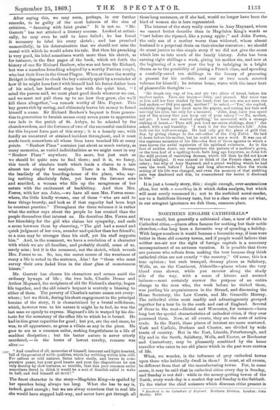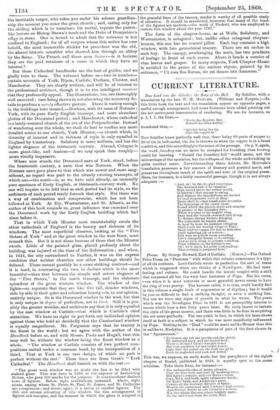NORTHERN ENGLISH CATHEDRALS.* Wrris a small, but generally a cultivated
class, a tour of visits to Cathedral cities,—places often famous for nothing but their noble churches,—has long been a favourite way of spending a holiday. With larger numbers it would become a favourite way, if inns were better in these old country towns, and if people would believe that neither sea-air nor the sight of foreign capitals is a necessary accompaniment of an autumn vacation. It is possible that there are persons who refrain from making the tour because they think cathedral cities are not exactly "the country." Of some, this is a true opinion ; but such tranquil, dreamy places as Salisbury, Wells, or, on the Continent, Abbeville—places where the very blood runs slower, while you saunter along the shady side of the way, with a sense of leisure and assured laziness—must certainly answer the purpose of an entire change to the man who, the week before he visited them, was jostling his acquaintances in the Strand, and discussing the Home Secretary, the Law Courts, and Mr. Grenville Murray. The cathedral cities most readily and advantageously grouped together for a tour lie in the south and east of England. Several of those in the west—Bristol and Worcester, for instance—have long lost the special characteristics of cathedral cities, if they ever possessed them. Now, at all events, they are the seats of active trade. In the North, these places of interest are more scattered. York and Carlisle, Durham and Chester, are divided by wide tracts of country. But in the East, Lincoln, Peterborough, and Ely and in the South, Salisbury, Wells, and Exeter, or Rochester and Canterbury, may be pleasantly combined by the home traveller who cares to see old places which in the past were centres of life.
What, we wonder, is the influence of grey cathedral towns upon those who habitually dwell in them? It must, at all events, be different from that of the manufacturing towns. For, in some sense, it may be said that in cathedral cities every day is Sunday, and Sunday is not dull : while in the money-getting towns of the North, every week-day is a market day and Sunday is the Sabbath. To the visitor the chief nuisance which diocesan cities present is
Handbook to the Cathedrals of England. Northern Division. London; John Murray. 1859. the inevitable verger, who takes you under his solemn guardian- ship the moment you enter the great church ; and, caring only for the shilling which is to terminate his recital, repeats the parrot- like lecture on Bishop Brown's tomb and the Duke of Dumpshire's effigy in stone. One is bound to admit that the nuisance is not confined to England ; for of all vergers whom this writer has ever beheld, the most immovable stickler for precedent was the old, the almost historic mumbler who showed him through an abbey by the Seine. The French call these men Suisses—is it because they are the paid retainers of a cause in which they have no interest?
But these Cathedral handbooks are the best of guides, and we gladly turn to them. The volumes before us—two in number— contain accounts of York, Ripon, Carlisle, Durham, Chester, and Manchester. They are clearly written, and will be of interest to the professional architect, though it is to the intelligent amateur that they professedly appeal. The illustrations, too, are thoroughly well executed ; care being shown in not obscuring the necessary de- tails to produce a merely effective picture. There is variety enough in the buildings here treated,—Durham, with its mass of Norman ; York, with its pure Early English transept, and more abundant glories of the Decorated period ; and Manchester, whose cathedral is a lately-restored church of the era of the Perpendicular. Instead of wandering over the whole, we shall do best to confine any more detailed notice to one church, York Minster,—a church which, in diversity of interest and in richness of style is only equalled in England by Canterbury. Salisbury is more uniform, and has the lighter elegance of the thirteenth century. Abroad, Cologne is more giant-like, and Amiens—if we may speak thus roughly— more vividly impressive.
Where now stands the Decorated nave of York, stood, before the fourteenth century, a nave that was Norman. When the Norman nave gave place to that which was newer and more mag- nificent, no regard was paid to the already existing transepts, of which one—the south—is, as we have said already, an unusually pure specimen of Early English, or thirteenth-century work. No one will require to be told that as each period had its style, so the architects of each period rarely forsook that style. But there was a way of combination and compromise, which has not been followed at York. At Ely, Westminster, and St. Alban's, as the author of this book reminds us, great influence was exercised over the Decorated work by the Early English building which had risen before it.
That in which York Minster most unmistakably excels the other cathedrals of England is the beauty and richness of its windows. The most superficial observer, looking at the "Five Sisters of York" and at the great window in the west front, must remark this. But it is not alone because of these that the Minster excels. Little of the painted glass, placed profusely about the building, was injured at the time of the Reformation ; and when, in 1644, the city surrendered to Fairfax, it was on the express condition that neither churches nor other buildings should be defaced. There cannot possibly be a more striking contrast—and it is hard, in contrasting the two, to declare which is the more beautiful—than that between the simple and severe elegance of the "Five Sisters," in the north transept, and the elaborate splendour of the great western window. The window of five lights—so separate that they are like five tall, slender windows, side by side in their quiet and colourless beauty—is, in our opinion, entirely unique. So is the Decorated window in the west, but that is only unique in degree of perfection, not in kind. Still it is pos- sibly the greater wonder, and architects say that it is only equalled by the east window at Carlisle—that which is Carlisle's chief attraction. We have no right to put forth our individual opinion against those who hold 80 decidedly that the Cumberland window is equally magnificent. Mr. Fergusson says that its tracery is the finest in the world ; but we agree with the author of the Handbook before us, and with Messrs. Poole and Hugall, that this may well be, without the window being the finest window as a whole. "The window at Carlisle consists of two perfect com- positions united under a common head, by the interposition of a third. That at York is one vast design, of which no part is perfect without the rest." These lines are from Gent's "York Cathedral." The Handbook shall furnish us with the rest :— " The great west window was no doubt the last to be filled with stained glass. This was done in 1388, at the expense of Archbishop Melton, who gave 100 marks for the purpose. It contains three distinct rows of figures. Below, eight archbishops, unnamed. Above, eight saints, among whom St. Peter, St. Paul, St. James, and St. Catherine are conspicuous ; and above, again, is a series of smaller figures. The rich and solemn colouring of this window, the fine arrangement of figures and canopies, and the manner in which the glass is adapted to the graceful lines of the tracery, render it worthy of all possible study of attention. It should be mentioned, however, that many of the heads of the figures are modern,—the work of Peckett, who was employed to restore this window about the year 1747."
The form of the chapter-house, as at Wells, Salisbury, and Westminster, is octagonal ; but, Finlike other octagonal chapter- houses, this one has no central pillar. Each bay contains a high
window, with late geometrical tracery. There are six arches in each bay. The canopy, overhanging the seats, has two pendants of leafage in front of each recess. Above it bends a cornice of vine leaves and grapes. In many respects, York Chapter-House is entitled to the praise of the ancient rhyme, painted by its entrance, " Ut rosa flos forum, sic eat domus ista domorum."































 Previous page
Previous page